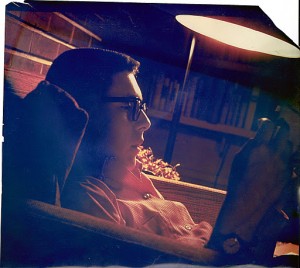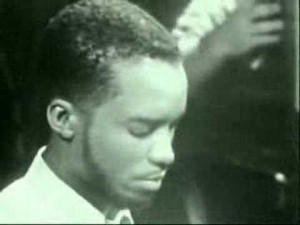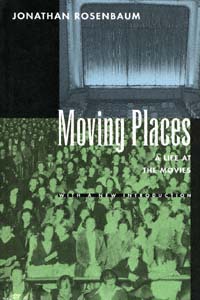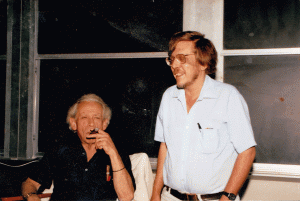This piece by Ehsan for Fandor’s Keyframe originally appeared on the day before my 70th birthday (February 26, 2013).– J.R.

Jonathan Rosenbaum at 15, imagination in the process of being liberated.
Jonathan Rosenbaum, at the cusp of seventy, talks about a life of jazz and cinema.
By Ehsan Khoshbakht February 26, 2013
The needs-no-introduction film critic Jonathan Rosenbaum turns seventy this month, but that does not mean that he has grown out of touch. His latest book, Goodbye Cinema, Hello Cinephilia (University Of Chicago Press, 2010), displays Rosenbaum’s engagement with digital-era realities, and manages something few if any critics of his generation are capable of in the current environment: optimism. Self-catalogued on his own website, the critic’s life of writing, from his late teens to the two-thousand-and-teens, coheres, and the collection of work is unmatched by any living film writer for its breadth and rigor. A closer look at his contribution to film literature (with featured articles in the weightiest of magazines and translations of his baker’s dozen books into languages as diverse as Chinese and Farsi) finds Rosenbaum generally bringing a sense of urgency to his subjects, no matter the decade.
My rather personal ties with the Chicago-based critic comes from our mutual love of jazz, which, aside from its ecstatic pleasures (that sometimes surpasses cinema’s), can assist writers in the ways they approach any other art form. Rosenbaum’s articles about jazz offer a wealth of insights in additional to being historically important and offering insight into the use of the jazz idiom in film literature. For the former I can point to his invaluable documentation and criticism of rare jazz films for Monthly Film Bulletin in the 1970s (I recently discovered his pioneering Black and Tan piece in the aforementioned publication has been the subject of ruthless plagiarism in a prestigious Duke Ellington biography) and as for the latter, I draw your attention to his first autobiographical and improvised book, Moving Places (Second Ed., University of California Press, 1995).
It’s no surprise (to me, at least) that jazz and its influence on film and writing is the subject of this particular conversation with the storied critic. Once Rosenbaum confessed to me that in his early teens, he fantasized briefly about becoming a jazz musician, “but then ruled out the possibility after deciding that the life lived by jazz musicians was too difficult and too grim.” Personally, I’m more than happy that jazz world didn’t rob us of this great cinephile who managed to bring wild notes to his chosen vocation.
Keyframe: You once wrote, ‘I used to dream of making a film — if someone were to hand me an outsize check and give me carte blanche, which of course I knew would never happen. I wanted to film all of my best friends dancing as uninhibitedly and joyfully as possible alongside the Seine, and then I wanted to devote the next several years of my life to synchronizing their movements to an up-tempo number by Ahmad Jamal’s piano trio.’ Why Ahmad Jamal?
Jonathan Rosenbaum: Maybe because there’s so much delight as well as delicacy in his playing, as well as an awesome dynamic range. Plus the fact that he swings so much, and plays with such marvelous economy.
Keyframe: How did you discover jazz and how your jazz life grew out of that moment?
Rosenbaum: One of my New York cousins while I was growing up, David Lelyveld, was a big fan of bebop and the Tristano school (especially Warne Marsh), and introduced me to those figures. But on my own I had already discovered many others, including Brubeck, Jamal, Miles (specifically, his ‘Round Midnight’ LP), the MJQ and Stan Kenton. And as mentioned in my autobiographical Moving Places (1980), on February 22, 1957, only five days before my fourteenth birthday, I went with my girlfriend at the time, Jean McIntosh, to hear a Louis Armstrong concert at the Sheffield Community Center, in northwestern Alabama, across the river from my hometown, Florence. (Because of the Jim Crow laws, we went to the 7 pm show for whites only, not the 9:30 show for “colored” only, although it’s worth adding that Satchmo played with his white drummer, Barrett Deems, at both concerts — someone whom I wouldn’t see perform live again for almost another forty years, when I caught him one New Year’s Eve in Chicago, shortly before his death.) I should add that my mother, who was deeply involved with classical music when she was younger, and played the piano for many years, also had a minor interest in jazz, and she once went to the trouble of getting me a few lessons from a local piano teacher who knew a little bit about jazz, taught me a few chords, and even gave me a couple of his old albums that he no longer listened to — Billy Taylor with Candido and the Oscar Peterson Trio (I no longer recall which album). I also played clarinet in my high school band, and participated in a few local jam sessions. (The usual drummer at those was Donnie Fritts, who years later became a professional pianist for Kris Kristofferson and a composer, and today still lives in Florence.)
Later, after I started college at New York University, I got to see a lot of stuff live — most notably (and this list is far from complete, and doesn’t include concerts), Mingus, Bud Powell, and Chico Hamilton at Birdland, Miles at the Jazz Gallery (I can recall one stupendous weekday evening — when I got in for only $1, a student discount price — he was playing with Coltrane, Cannonball, J.J. Johnson, Bill Evans, Paul Chambers and Philly Joe; and, believe it or not, the Teddy Wilson Trio was playing alternate sets), Miles and Mingus and Bill Evans with Scott LaFaro (among many others) at the Village Vanguard, Roland Kirk and Monk and Ornette Coleman at the Five Spot, and Coltrane’s classic quartet as well as Tristano with Marsh and Konitz at the Half Note, Kenny Dorham as well as Roland Kirk at Slug’s, and Archie Shepp at some long-gone hangout only a block away from NYU. I also saw Martial Solal and Billy Taylor on separate occasions at the Hickory House, but this was probably some years later. Actually, I went to see Mingus at many clubs, with many separate groups, and one of my fondest memories from that period was going up to him at many of those dates and requesting that he play “Peggy’s Blue Skylight,” which he always did.
After three semesters at NYU, I transferred to Bard College, a two-hour train ride up the Hudson River, where I learned some more piano chords from a few classmates, played in a few jam sessions (at which Chevy Chase played drums — and I once also accompanied Blythe Danner when she sang Round Midnight at a club on campus), and heard more live jazz in New York during some weekends. I also produced one concert there myself (hiring Herbie Hancock, Ron Carter, and Tony Williams) and helped to promote another one that was produced by Chevy and Blythe, performed by The Bill Evans Trio….Incidentally, during my five years in Paris, I was friendly for a brief period with the avant-garde alto sax player Noah Howard, and did an interview with him that I sent off to Downbeat. They didn’t accept it, but the editor, Don Morgenstern, wrote me back, encouraging me to submit more pieces, which I never did.
Keyframe: How did you incorporate various elements of jazz (mainly improvisation) into your film criticism or your writing in general?
Rosenbaum: Liberating one’s imagination is obviously part of this, and the rhythm of one’s prose is another part. In Moving Places, the fact that I did a lot of factual research before I did most of the writing was for me a lot like establishing the chords or changes before inventing a solo to ride over them.
Keyframe: ‘Jam Session on Non-Narrative’ was the intriguing subtitle of a 1978 article of yours. What is the significance of jazz improvisation to you, especially when it comes to film literature?
Rosenbaum: In this case, the notion of group improvisation was obviously important — complicated by the fact that the two other participants in ‘Obscure Objects of Desire,’ Raymond Durgnat and David Ehrenstein, only met for the first time several years after the piece was done. Of course, one of the best things that can happen in a jam session is one idea sparking or giving rise to another; and sometimes one idea can even synthesize one or two other ideas from one or two other individuals preceding it.
Keyframe: Although it is improvisation which is usually associated with jazz as the most prominent and influential factor in that music, but for many jazz musicians another term is highly in use: that of ‘swing.’ We may both agree that it is utterly indefinable, while its connection to a specific rhythmic pulse (which causes joy) is unquestionable, and, to borrow from Richard Cook, it always conveys a sense of forward momentum. Improvisation has been used in cinema and other arts, but is there any possibility that we can employ ‘swing,’ too? Personally, I think this feature — which more or less is related to use of language — can be traced in writings of two essentially American critics, Whitney Balliett (in jazz) and Manny Farber (in cinema). Do you see any practicality in borrowing the term from jazz for our use in film literature?
Rosenbaum: I wouldn’t know how to answer this, except to agree with you that Farber and Balliett both swing (unlike, say, Agee or Ferguson or Martin Williams or even Hodeir as a critic, whatever their other virtues). And, as I believe I’ve already indicated to you in the past, I think Rafi Zabor’s descriptions of jazz solos in his novel The Bear Comes Home swing like crazy.
Keyframe: Speaking of André Hodeir, you were his colleague in Cinema: A Critical Dictionary, and of course he was a great jazz historian and jazz critic who also wrote about cinema. Have you met him in person?
Rosenbaum: No, never, alas. But I’ve met and befriended his major English-language translator, Noël Burch, who was also a teaching colleague of his for many years. For me, Hodeir is something of a role model, especially in what he’s taught me about form, and in some ways more as an artist than as a critic — especially his masterpiece Anna Livia Plurabelle — although I also love it when, as a critic, he compared Gil Evans’ work transforming the compositions of others on Miles Ahead with the work of Jorge Luis Borges. More generally, I think he’s had more to say (and do) regarding the interface between jazz and literature than anyone else has. For instance, I’m fascinated by the fact that, even when he arguably has his singers on Anna Livia Plurabelle mispronounce some of Joyce’s puns, there always seems to be a good musical reason for him doing this. And the fact that this long work undergoes continual transformations is part of its power, even though not a single note in it is improvised. I do think it swings, however.
Keyframe: Generally speaking, I don’t remember any outstanding reference to jazz among the Cahiers circle, and more interestingly, not even in their films, while they had the benefit of hosting many American jazz expatriates in Paris of the late 1950s. For instance, in the four-volume English translation of selected Cahiers articles, the word ‘jazz’ has been used only once. Since you know the cultural environment of France in the 1960s, how do you explain the absence of jazz in Cahiers’ criticism?
Rosenbaum: A good question, but I don’t know the answer, except to say that Godard, Truffaut, Rivette, Rohmer and Straub-Huillet could basically be described as classicists rather than modernists when it comes to music (with a few notable exceptions, such as the Stockhausen percussion piece effectively used in La chinoise). It seems evident now that Solal’s excellent score for Breathless came about mainly because of the producer rather than because of Godard’s own taste — even though Godard once said to me in an interview that there was more ‘story’ in Patti Smith or John Coltrane than there was in most current movies.
Keyframe: Speaking of representation of jazz in movies, it seems not much has changed since you wrote ‘three errors in four words,’ as De Niro in New York, New York was called ‘a gifted avant-gardist playing bebop.’ How would you ‘update’ your comments on the matter of representation?
Rosenbaum: There was a brief period, a few years ago, when I thought that I, or John Bailey and I, might be making a jazz documentary about McCoy Tyner, to be produced by Rick Schmidlin (the producer of the Touch of Evil re-edit), which once led to me meeting Tyner in Chicago and discussing the project with him over several hours. I’ve already posted something about this on my web site (jonathanrosenbaum.net), so all I’d like to emphasize here is my conviction that the main missing element in most depictions of jazz on film is musicians listening to one another. (As I said to Tyner, one of the most memorable things about the Coltrane Quartet at the Half Note was the intense way they listened to one another — and I also have a powerful memory of sitting next to Tristano late one night at the Half Note’s bar, after his last set, while he was playing back a tape of his own group with Marsh and Konitz, and reacting very audibly as well as visibly to what he liked or didn’t like in each of the solos, including his own….Recently watching the beginning of Ingmar Bergman’s film of The Magic Flute, I was especially struck by the way he focused on listeners in the audience. But the way he cut and moved his camera in relation to the music was also impressive, and could probably be studied with profit by the makers of jazz documentaries.
I think, incidentally, that your recent critique of the late Bruce Ricker’s Dave Brubeck: In His Own Sweet Way was quite just, all things considered — even though I was much more generous to it myself. This was largely because Ricker himself, whom I met several times, was so generous to me, and not only in jazz-related matters. Although the fact that he was kind enough to Fedex a DVD of this film to me in Richmond while I was languishing there, after I had asked him if I could see it, obviously enhanced my appreciation. Even so, I’m sure that The Last of the Blue Devils, which I haven’t reseen in some time, must be a lot better as a film. (I still haven’t seen his documentary about Jim Hall.) [Postscript, December 2013: Thanks to Ehsan’s own wonderful jazz blog, I’ve now seen the film, which he posted shortly after Hall’s death, and it’s wonderful.]
Keyframe: It comes as a surprise that one of the best examples of employing jazz in cinema is accomplished by Iranian film director, Abbas Kiarostami and his Taste of Cherry that truly exploits the emotional depth and integrity of ‘St. James Infirmary,’ played by Louis Armstrong. It clearly stands in contrast to, let’s say Woody Allen, who knows jazz and plays jazz, but his use of this music is limited to nostalgic functions and not necessarily a very clever one. What do you think is the key to Kiarostami’s unique achievement in there — a man who is not specifically a jazz fan.
Rosenbaum: I think I can answer this in one word: soul. But, for whatever it’s worth, I also loved the use he made of ‘Autumn Leaves’ when I once got to see ABC Africa on an editing table in work print form. He later told me that he decided to use a different kind of music there precisely because ‘Autumn Leaves’ was noticed and recognized by viewers, which wasn’t the kind of response he wanted at that point. This makes perfect sense to me, although I still wish that he’d kept it in.
Keyframe: Do you see any relation between your favorite jazz musicians and favorite film directors?
Rosenbaum: I’ve always thought that Mingus had a lot in common with Godard, especially in the way he incorporated both cultural history and the history of his own art, obliterating many of the distinctions we often make between modern and classical or at least making most of them seem secondary. Also, I think both are political, polemical, and stylistically eclectic in many comparable ways. They both have a genius for bringing together styles, forms, and even topics that are generally believed to be incompatible.
Keyframe: As someone who has shown strong ties, as well as intellectual commitment to both art forms — jazz and cinema — how do you think it has widened your scope?
Rosenbaum: A loose observation I can make linking jazz and film and writing for me, or what I like about all three: I’m preoccupied in a lot of my work with the coexistence of being alone in one’s expressiveness and being part of a collective or a community, and discovering expressiveness that way. For me, much of the best jazz, film and writing grows out of a dialectic between these two kinds of expressiveness, as well as two kinds of response to that expressiveness.
This article is being cross-published with Film Monthly (Farsi/Persian) and Dilema Veche (Romanian). For more on Rosenbaum’s jazz writing, see Ehsan Khoshbakht’s blog, where he’s created a jazz-article index for Rosenbaum.




